Care for a side of bigotry with that green eggs and ham?
On Tuesday the beloved children’s book author Theodor Seuss Geisel’s birthday, it was announced by the Dr. Seuss Enterprises that 6 of his classic children’s books will no longer be published because “they portray people in hurtful and wrong ways.”
A study found that after studying 50 books by Dr. Seuss 43 out of 45 characters of color have characteristics aligning with the definition of “orientalism” or the stereotypical offensive portrayal of Asia.
One of the books cited was “And to Think That I Saw It on Mulberry Street,” where an Asian person is portrayed wearing a conical hat, holding chopsticks, and eating from a bowl.
Oh, the places Dr. Seuss went before!
WWII
Long before he penned his series of children’s books, Theodor Geisel worked as a political cartoonist from 1941-1943 creating more than 400 political cartoons for liberal NY Newspaper PM. Along with subjects such as racial discrimination and social injustices, he did create anti-Japanese propaganda and supported Japanese internment.
Though it is baffling to see Geisel who railed against racism, Jim Crow, and anti-Semitism in his cartoons also offer up bigoted depictions of Asians both in the US and overseas, it is important to be viewed in the context of the times.
In fairness to Dr. Seuss, it serves as a guide to note the normalcy of prejudice especially against Asians in mainstream America. That was Life in these United States!
The demonization of Japanese Americans during WWII could serve as a history lesson in what happens when racist propaganda is disseminated as patriotism.
And it didn’t take long.
A mere two weeks after the December 7, 1941 attack on Pearl Harbor, a racist guide geared to the hapless American to differentiate a Jap from the Chinese was published in two highly respected periodicals Life Magazine and Time as a public service to a frightened public.
Slap the Jap –That’s Life
After Japan’s surprise attack on America, fear and hysterics ran high.
Like most Americans in December of 1941, Bob White was in a state of anxiety. Shaken to the core by this violent act of terrorism perpetrated against America in Pearl Harbor, he was left confused. Like others, Bob simply didn’t know who to trust.
This native of Newberg worried…was the Chinaman washing his shirts really Chinese or a Japanese spy. Maybe the Oriental whose family fix-it shop had been there for generations might be sending signals back to Tojo. Who could tell if they were even Japanese?
Life magazine understanding this confusion came to his rescue.
In a world of insecurity and uncertainty, Bob White could count on 3 things. A white Christmas, the regular delivery of the U.S. mail, and the reassurance from his favorite magazine Life.
Like most Mondays, Bob looked forward to his weekly copy of Life, the eyes and ears and voice of America to entertain, inform and instruct him.
But this December 22 was not like most Mondays. Only 2 weeks earlier President Roosevelt had appeared before Congress asking them to declare war on Japan. The date that would live in infamy was fresh in American minds.
So when the doorbell rang at noon, Bob could count on it being the mailman making his delivery. As Sam the mailman shook off the snow and handed Bob his weekly copy of Life, he smiled and said winking: “It’s a keeper!”
Long May She Wave
Bob’s heart swelled with pride at the image of the majestic waving American flag that filled the cover of the magazine.
Flipping through the thick periodical he pored over the graphic photos documenting the devastation from the attack in Hawaii, fueling his hatred of the cruel and barbaric enemy. The jingoistic copy confirmed what Bob knew in his heart – harnessing America’s might we would pull together to beat the Japs!
Reading onward, his eyes fell on the bold-face heading “War and Terrorism” under which he noted a series entitled “The Handbook for Americans.”
This former Eagle Scout knew that to win this war both on the battlefield and on the home front, Americans needed to be prepared.
Americans needed to mentally awake and morally straight and most importantly, keep informed. Like any good handbook, this one offered practical, useful information.
The first article in the handbook was a handy guide for identifying dangerous Japanese warplanes.
But more urgent than the planes was the vital information on how to identify a Jap.
Friendly Persuasion
Yes, not only does the reader learn to recognize enemy Jap warplanes, identifying them by their unique markings, they learn to distinguish Japanese Americans from Chinese Americans.
Not unlike most Americans, Bob tended to lump all members of the “yellow race” together.
It was Life’s mission to carefully point out the differences concerned that our anger and contempt not be directed at our good Chinese friends but at the Japanese.
Bob sighed in relief. Finally a helpful guide to identifying the real enemy.
It was a major task, but Life made it so much easier.
Entitled “How to Tell Japs From the Chinese:” Bob read with interest as the article explained:
“In the first discharge of emotions touched off by the Japanese assaults on their nation, US citizens have been demonstrating a distressing ignorance of the delicate question of how to tell a Chinese from a Jap. Innocent victims in cities all over the country are many of the 75,000 U.S. Chinese whose homeland is our staunch ally.
So serious were the consequences threatened, that the Chinese consulates last week prepared to tag their nationals with identification buttons.
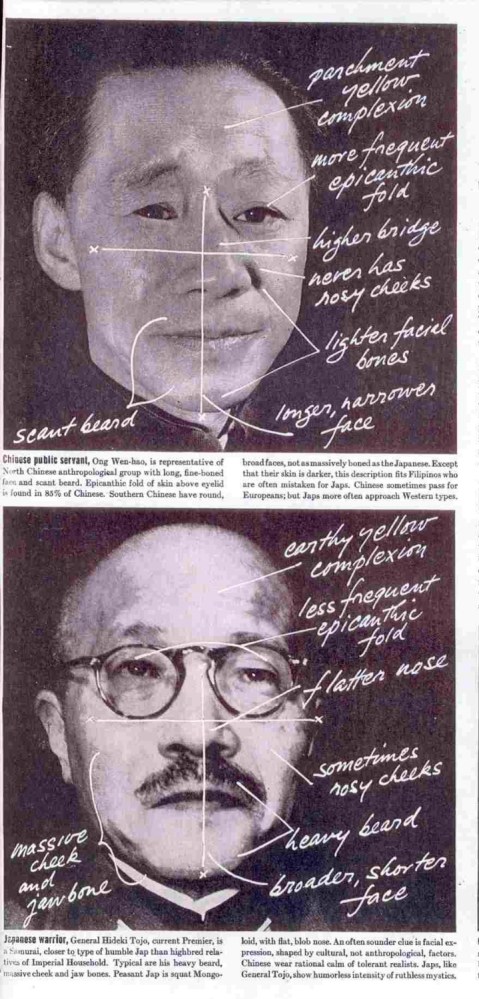
These photographs are marked with crudely notated facial features such as an anthropologist might compare one animal to another. Life Magazine December 22, 1941
Lest you engage in a friendly conversation with a Japanese American store clerk this handy guide would protect you from this dangerous encounter.
To dispel some of this confusion between Asian friend and foe , LIFE provided a rule-of-thumb for characteristics that distinguished friendly Chinese from the enemy alien Japs.
As in the warplane article, Bob learned how to differentiate between Japanese and Chinese people, with “instructive, easily interpreted diagrams and photographs.
The article’s “helpful captions” explain distinctive bones structures and facial features” with the arbitrariness and stereotypes worthy of an instructor of eugenics .
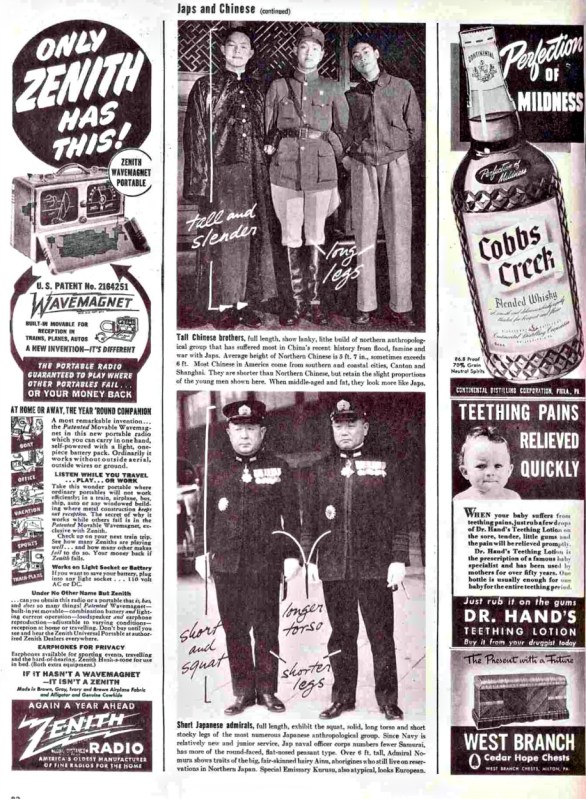
American racism 100% proof. The second page of the article is framed between two columns of advertisements. Americans consume their racism along with their whiskey.
The Chinese we learn, are smiling and friendly the Japanese is frowning and angry.
The engaging Chinese man is described as a “public servant,” while the Japanese man ( General Tojo) is listed as a “Japanese warrior” whose face “shows the humorless intensity of ruthless mystics.”
Across the street, Bob’s neighbor Mary was picking up her own mail, anxious to read her issue of Henry Luce’s other publication Time. It too carried its own helpful article “How to Tell Your Friends From the Jap.”
It wasn’t long before distinguishing between a Jap and Chinese would be as easy as identifying an enemy airplane with their handy-go-to guide. Everything you needed to prevent you from mistaking your friendly Chines storekeeper for a Japanese American traitor
Life would help you identify the enemy and properly direct your hatred to the appropriate source. To a frightened hysterical public, it came in the nick of time.
Hatred of the other because of fear is dangerous. Deplorable acts of racism somehow justified and even honorable in the time of terror and war end up with predictably terrible consequences.
© Sally Edelstein and Envisioning The American Dream, 2021







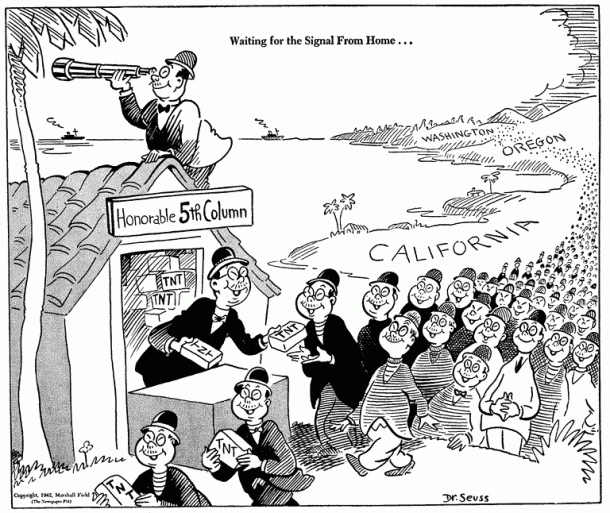
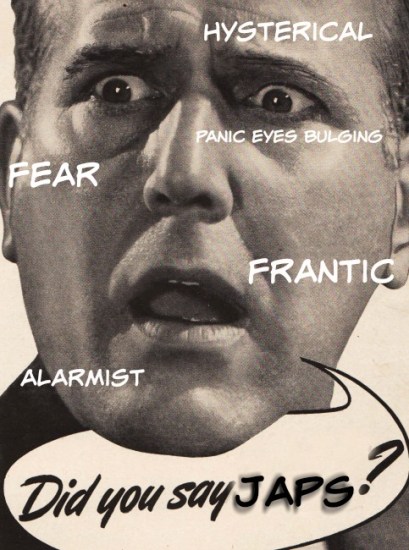



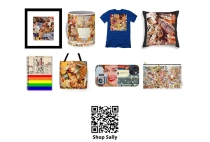



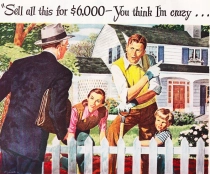
Sally, two bookend comments. Your last paragraph speaks volumes. Full stop
“Hatred of the other because of fear is dangerous. Deplorable acts of racism somehow justified and even honorable in the time of terror and war end up with predictably terrible consequences.”
On the flip side, I hope this does not unduly taint the good legacy of what Dr. Seuss did in his more meaningful work. We are all imperfect and have done things we regret or would be surprised we did when revealed after 25 years. Of that, I am 100% certain. I would hate to see all the stupid things I said and did laid before me now. What will happen is we will silence too many good voices for their worst behaviors.
Yet, as you note there are things we must reconsider and take out of mainstream press. The annual “Huck Finn” debate on whether to include all of his narrative is a good example. The book is about pointing out the stupidity of racism, but it uses highly derogatory language, meant to offend and make you think. The fact the language may be euphemized, does not take away from Twain’s powerful statement that racism is unwise and based on fear.
Thanks for the good post. Keith
LikeLiked by 2 people
After the war, he questioned his beliefs about the Japanese. Years later Dr. Seuss wrote, “Horton Hears a Who” ( a metaphor for the American postwar occupation of Japan) in part as an apology to the Japanese that he had demonized during the war. Dr Seuss brought and continues to bring a great deal of joy to many. As an editorial cartoonist, he did a lot of work against social injustice.
LikeLiked by 1 person
Brilliant. And what great research and images. Bravo!
LikeLiked by 1 person
Thanks! Glad you enjoyed the piece.
LikeLiked by 1 person
My 5th grade teacher (in 1958) mentioned that the decorative rising sun above her home’s front door caused her lawyer husband and her concern during WWII because of the fear ignorant idiots would think they somehow supported the Japanese! Unfortunately, this part of the US has no end of ignorant idiots, and the WWII variety gave us the generations that voted for a certain former president, tice!
LikeLike
That’s remarkable that decorative imagery might be confused with an ethnic/national connotation. Wartime does that to people and brings out the worst in some folks.
LikeLike
Put the flag on a pole, wave it around, and there are people who will do stupid things like storm the US Capitol and think they are patriots.
LikeLike
Thank you for this.
LikeLike
I’m glad you enjoyed it.
LikeLiked by 1 person
I got a copy of the book “Dr. Seuss $ Co. Go to War” in my library. It’s got a few of his cartoons in it (and plenty of others from editorial cartoonists of the time, mostly from PM I believe… been a while since I read through it). And the cartoons against the Japanese are definitely cringe, his and others. The ones with Hitler are more ridiculous or impassioned.
It’s a hard subject, certainly worthy of study and discussion. Like any medium, they’re the products of their times, and Seuss felt pretty bad about it later in life, though dehumanizing the enemy was the name of the game on all sides. He still felt remorse for the things he wrote. That is very important to remember. And that’s why Horton Hears a Who is so important, too, because the book is a teaching tool on multiple fronts. I was much older when I read that one and I got the message pretty easily… and bought it as soon as I learned the full story.
LikeLiked by 1 person
(it’s supposed to be “Seuss & Co”, but I can’t type today, dang it. Too tired.)
LikeLiked by 1 person
You are right about the importance of Horton Hears a Who. It was his attempt to right a wrong.
LikeLiked by 1 person
And now because of the Covid-19 pandemic anyone of Asian descent is being attacked nowadays. It makes me angry as Hell! (I personally blame Donald J. Trump for today’s hateful attacks. He started it.) No one is blaming a Dr. Seuss book for these attacks on Asian-Americans.
Many years from now our descendants will say, “it is important to be viewed in the context of the times.”
We need to “get it right” before the fall western civilization.
Well, that’s my two-cents. Thanks.
LikeLiked by 1 person
There is no question at all that the blame for the increased violence and hate directed at Asian Americans comes from Trump. His insistence on referring to the virus as “The China Virus” fueled and fanned this hatred. There seem to be so many opportunities to get it right and we seem to always fall short.
LikeLike
Never ever believe in propaganda and rhetoric. I grew up on Dr. Seuss. He did a fantastic job of writing and creating. May many others find the creativity in themselves.
LikeLike